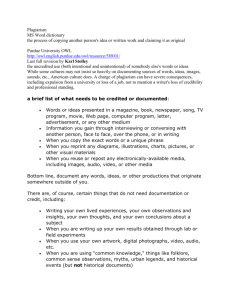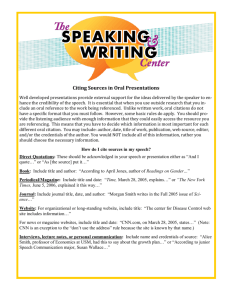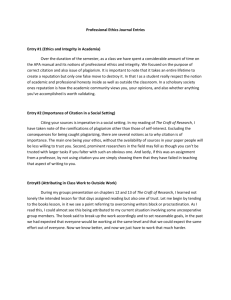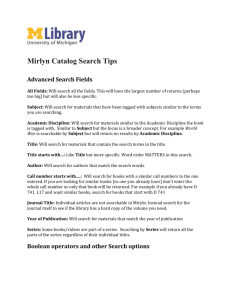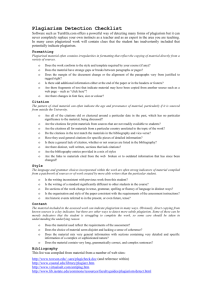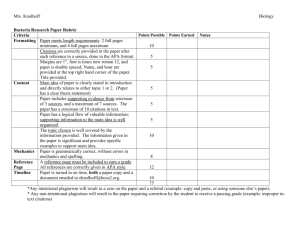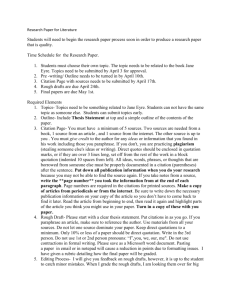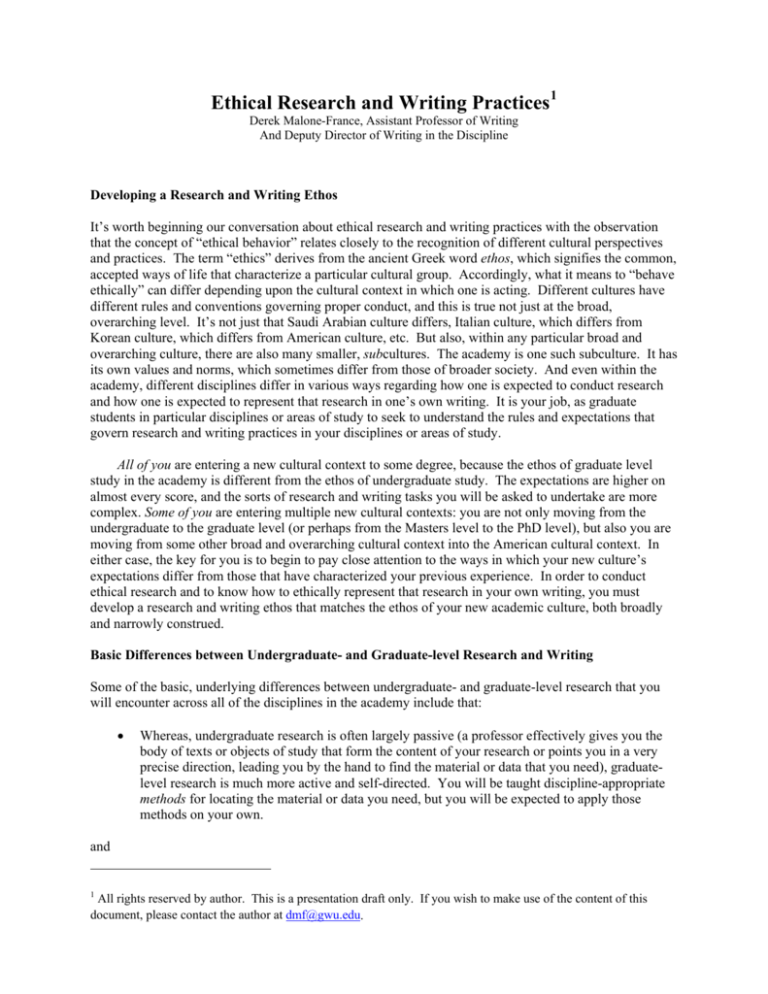
Ethical Research and Writing Practices1
Derek Malone-France, Assistant Professor of Writing
And Deputy Director of Writing in the Discipline
Developing a Research and Writing Ethos
It’s worth beginning our conversation about ethical research and writing practices with the observation
that the concept of “ethical behavior” relates closely to the recognition of different cultural perspectives
and practices. The term “ethics” derives from the ancient Greek word ethos, which signifies the common,
accepted ways of life that characterize a particular cultural group. Accordingly, what it means to “behave
ethically” can differ depending upon the cultural context in which one is acting. Different cultures have
different rules and conventions governing proper conduct, and this is true not just at the broad,
overarching level. It’s not just that Saudi Arabian culture differs, Italian culture, which differs from
Korean culture, which differs from American culture, etc. But also, within any particular broad and
overarching culture, there are also many smaller, subcultures. The academy is one such subculture. It has
its own values and norms, which sometimes differ from those of broader society. And even within the
academy, different disciplines differ in various ways regarding how one is expected to conduct research
and how one is expected to represent that research in one’s own writing. It is your job, as graduate
students in particular disciplines or areas of study to seek to understand the rules and expectations that
govern research and writing practices in your disciplines or areas of study.
All of you are entering a new cultural context to some degree, because the ethos of graduate level
study in the academy is different from the ethos of undergraduate study. The expectations are higher on
almost every score, and the sorts of research and writing tasks you will be asked to undertake are more
complex. Some of you are entering multiple new cultural contexts: you are not only moving from the
undergraduate to the graduate level (or perhaps from the Masters level to the PhD level), but also you are
moving from some other broad and overarching cultural context into the American cultural context. In
either case, the key for you is to begin to pay close attention to the ways in which your new culture’s
expectations differ from those that have characterized your previous experience. In order to conduct
ethical research and to know how to ethically represent that research in your own writing, you must
develop a research and writing ethos that matches the ethos of your new academic culture, both broadly
and narrowly construed.
Basic Differences between Undergraduate- and Graduate-level Research and Writing
Some of the basic, underlying differences between undergraduate- and graduate-level research that you
will encounter across all of the disciplines in the academy include that:
•
Whereas, undergraduate research is often largely passive (a professor effectively gives you the
body of texts or objects of study that form the content of your research or points you in a very
precise direction, leading you by the hand to find the material or data that you need), graduatelevel research is much more active and self-directed. You will be taught discipline-appropriate
methods for locating the material or data you need, but you will be expected to apply those
methods on your own.
and
1
All rights reserved by author. This is a presentation draft only. If you wish to make use of the content of this
document, please contact the author at dmf@gwu.edu.
•
Whereas undergraduate research and writing often ask little more of you than that you
demonstrate and ability to accurately report on the findings or ideas of others, in graduate school
you will be expected to demonstrate an ability to locate information and/or extrapolate data that is
not readily available and that does not merely representative of the prior work of others, and you
will be expected to develop ideas that are truly your own, displaying an ability to think in original
ways that move a discussion or debate in your discipline forward in some substantive manner.
It is important to recognize that these two fundamental differences between undergraduate- and graduatelevel research are inextricably connected to one another. If you cannot conduct research that either
reveals new information or ideas or re-analyses existing information and ideas in a new way, then you
cannot produce writing that goes beyond reporting what others have already said, in order to say
something new yourself.
Plagiarism
It is also important to recognize that, as part of an ethos of academic work, these expectations that you
will now face throughout your time in graduate school here at GW are not just expectations regarding
performance, they are expectations of ethical behavior, and, as such, they carry with them potentially
severe consequences. For example, while in some cultures it is considered perfectly appropriate, even in
graduate level academic writing, to use the data, ideas, or words of others without attribution—that is, to
present others’ data, ideas, or words without clearly signaling to the reader that they are, in fact, someone
else’s, in American academic culture such unattributed borrowing of others’ data, ideas, or words is called
plagiarism, and it is considered to be a profound violation of the ethos of academic work, and,
accordingly, it is treated with great seriousness and subject to harsh penalties, sometimes including failure
of a course or, in the most egregious cases, even expulsion from a degree program.
In short, in American academic culture, you must explicitly acknowledge the sources of any data,
ideas, or words that you have found in the work of others. Unless a fact, idea, or conclusion is “common
knowledge” within your discipline, you must report to your reader where you found it. And under no
circumstances may you either quote directly from or even paraphrase the words of other writers without
drawing your reader’s attention to their work with a full bibliographic citation.
And to those of you who have grown up in or have previous experience with American academic
culture, I would say, be sure not to assume that this necessarily means that you know everything that you
need to know about plagiarism and how to avoid it. For example, I find that many American students
who understand perfectly well that you may not borrow the words or thoughts of other writers without
citing them do not understand that you also may not borrow your own words from previous writing that
you have done, say in another class, without citing that previous work.
Citations
Let’s be clear about what citations are: Citations are formal acknowledgements of sources. There
function is two-fold. First, signal to your readers when and where within your writing you are drawing
upon the work of others. Second, they tell your readers where to locate those other sources, so that they
can retrace your research process and confirm that you have represented your sources accurately and
fairly. Therefore, a citation must include sufficient information about the source to which it refers to
allow the reader to locate it herself. Different kinds of sources will be identified in different ways. You
will give different information to a reader in order to help her locate a book or article than you would to
help her locate a website, or a person, of a geographical object. But in any one of these cases, the rule of
thumb is the same, provide any and all information required so that the reader can find what you found.
Beyond that, you should follow the specific rules for presenting and formatting citations that are
common to your discipline or field of study. At the very beginning of your graduate career, you should
determine what “style” or “styles” of citation is or are common in your discipline or field and begin to
practice employing it or them regularly and rigorously in your writing. Many humanities-based
disciplines and fields make use mainly of the MLA style of citation, which comes from the Modern
Languages Association. Others use the “Chicago” style, based upon the style manual published by the
University of Chicago. Most of the social sciences use the APA style, which was developed by the
American Psychological Association. In the natural sciences, there are many very specific styles of
citation that correspond to very specific genres of writing, such as lab reports. The sooner you master the
citational forms that are common in your discipline or field, the sooner you will be able to focus your
attention of the more substantive aspects of the research and writing process, without being distracted by
having to keep going back-and-forth between your citations and the rulebook to make sure you are doing
it correctly.
Determining What is “Common Knowledge”
One thing that I said a moment ago may need some clarification. I indicated that you do not need to cite a
source when you are referring to something that is “common knowledge”. But how does one know when
something is common knowledge, as opposed to original information that must be cited? There is no
absolute, black-and-white answer to this question. However, there are a couple of rules of thumb you can
employ.
•
First of all, if a piece of information or a definition of a concept or general idea is available in
sources such a dictionaries or encyclopedias, it can be treated as common knowledge within
whatever discipline or field of study it is relevant.
•
Second, if the information is available in numerous locations that are reputable sources within the
relevant discipline or field of study, and these sources do not bother to cite some original source
of the information themselves, then you may treat it as common knowledge in that discipline or
field of study.
Of course, when in doubt, cite.
The following information on “Best Practices” for students comes from a statement on plagiarism
by the Council of Writing Program Administrators.
The full statement can be found at: http://www.wpacouncil.org/node/9
Safe Practices
Most students, of course, don't intend to plagiarize. In fact, most realize that citing sources actually builds
their credibility for an audience and even helps writers to better grasp information relevant to a topic or
course of study. Mistakes in citation and crediting can still happen, so here are certain practices that can
help you not only avoid plagiarism, but even improve the efficiency and organization of your research
and writing.
Best Practices for Research and Drafting
Reading and Note-Taking
•
In your notes, always mark someone else's words with a big Q, for quote, or use big quotation
marks
•
•
Indicate in your notes which ideas are taken from sources with a big S, and which are your own
insights (ME)
When information comes from sources, record relevant documentation in your notes (book and
article titles; URLs on the Web)
Interviewing and Conversing
•
•
•
•
Take lots of thorough notes; if you have any of your own thoughts as you're interviewing, mark
them clearly
If your subject will allow you to record the conversation or interview (and you have proper
clearance to do so through an Institutional Review Board, or IRB), place your recording device in
an optimal location between you and the speaker so you can hear clearly when you review the
recordings. Test your equipment, and bring plenty of backup batteries and media.
If you're interviewing via email, retain copies of the interview subject's emails as well as the ones
you send in reply
Make any additional, clarifying notes immediately after the interview has concluded
Writing Paraphrases or Summaries
•
•
•
•
•
Use a statement that credits the source somewhere in the paraphrase or summary, e.g., According
to Jonathan Kozol, ....
If you're having trouble summarizing, try writing your paraphrase or summary of a text without
looking at the original, relying only on your memory and notes
Check your paraphrase or summary against the original text; correct any errors in content
accuracy, and be sure to use quotation marks to set off any exact phrases from the original text
Check your paraphrase or summary against sentence and paragraph structure, as copying those is
also considered plagiarism.
Put quotation marks around any unique words or phrases that you cannot or do not want to
change, e.g., "savage inequalities" exist throughout our educational system (Kozol).
Writing Direct Quotations
•
•
•
•
•
•
Keep the source author's name in the same sentence as the quote
Mark the quote with quotation marks, or set it off from your text in its own block, per the style
guide your paper follows
Quote no more material than is necessary; if a short phrase from a source will suffice, don't quote
an entire paragraph
To shorten quotes by removing extra information, use ellipsis points (...) to indicate omitted text,
keeping in mind that:
o Three ellipsis points indicates an in-sentence ellipsis, and four points for an ellipsis
between two sentences
To give context to a quote or otherwise add wording to it, place added words in brackets, []; be
careful not to editorialize or make any additions that skew the original meaning of the quote—do
that in your main text, e.g.,
o OK: Kozol claims there are "savage inequalities" in our educational system, which is
obvious.
o WRONG: Kozol claims there are "[obvious] savage inequalities" in our educational
system.
Use quotes that will have the most rhetorical, argumentative impact in your paper; too many
direct quotes from sources may weaken your credibility, as though you have nothing to say
yourself, and will certainly interfere with your style
Writing About Another's Ideas
•
•
•
Note the name of the idea's originator in the sentence or throughout a paragraph about the idea
Use parenthetical citations, footnotes, or endnotes to refer readers to additional sources about the
idea, as necessary
Be sure to use quotation marks around key phrases or words that the idea's originator used to
describe the idea
Maintaining Drafts of Your Paper
Sometimes innocent, hard-working students are accused of plagiarism because a dishonest student steals
their work. This can happen in all kinds of ways, from a roommate copying files off of your computer, to
someone finding files on a disk or pen drive left in a computer lab. Here are some practices to keep your
own intellectual property safe:
•
•
•
•
Do not save your paper in the same file over and over again; use a numbering system and the
Save As... function. E.g., you might have research_paper001.doc, research_paper002.doc,
research_paper003.doc as you progress. Do the same thing for any HTML files you're writing for
the Web. Having multiple draft versions may help prove that the work is yours (assuming you are
being ethical in how you cite ideas in your work!).
Maintain copies of your drafts in numerous media, and different secure locations when possible;
don't just rely on your hard drive or pen drive.
Password-protect your computer; if you have to leave a computer lab for a quick bathroom break,
hold down the Windows key and L to lock your computer without logging out.
Password-protect your files; this is possible in all sorts of programs, from Adobe Acrobat to
Microsoft word (just be sure not to forget the password!)
Revising, Proofreading, and Finalizing Your Paper
•
•
Proofread and cross-check with your notes and sources to make sure that anything coming from
an outside source is acknowledged in some combination of the following ways:
o In-text citation, otherwise known as parenthetical citation
o Footnotes or endnotes
o Bibliography, References, or Works Cited pages
o Quotation marks around short quotes; longer quotes set off by themselves, as prescribed
by a research and citation style guide
o Indirect quotations: citing a source that cites another source
If you have any questions about citation, ask your instructor well in advance of your paper's due
date, so if you have to make any adjustments to your citations, you have the time to do them well

